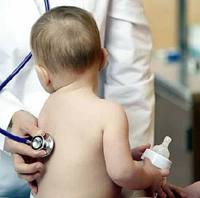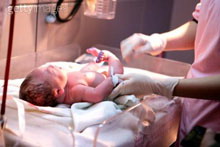Does the vaccine need from hepatitis? What are the vaccination schemes? What to do if the child did not put in the hospital? These and many other questions about vaccination can be found in this article.
Content
What you need to know about vaccination against hepatitis in
Hepatitis B is an infectious disease disease caused by the same virus. Unfortunately, this viral liver damage is one of the most frequent and widespread.
 Worldwide, the number of people infected with the hepatitis B virus exceeds 2.1 billion. At the same time, about 1 million people are dying from acute and chronic hepatitis in. However, the disease is dangerous not only by its prevalence and a large number of fatal outcomes, but also a significant number of people with disabilities among the persistent. Up to 10% of adults and up to 50-90% of children who have undergone acute hepatitis B are becoming viruses, the infection of them acquires a chronic course with high risk of developing cancer and liver cirrhosis . At the same time, the hepatitis B virus, according to experts of the World Health Organization (WHO), is the main causative agent of the primary liver cancer - up to 80% of all cases.
Worldwide, the number of people infected with the hepatitis B virus exceeds 2.1 billion. At the same time, about 1 million people are dying from acute and chronic hepatitis in. However, the disease is dangerous not only by its prevalence and a large number of fatal outcomes, but also a significant number of people with disabilities among the persistent. Up to 10% of adults and up to 50-90% of children who have undergone acute hepatitis B are becoming viruses, the infection of them acquires a chronic course with high risk of developing cancer and liver cirrhosis . At the same time, the hepatitis B virus, according to experts of the World Health Organization (WHO), is the main causative agent of the primary liver cancer - up to 80% of all cases.
The source of viral hepatitis B is a person with an acute or chronic form of the disease, or a virus monitor (which in the body the infection has not yet manifest itself)). In the popular literature, hepatitis is often called parenteral hepatitis (from Greek: Para - a retreat from the usual + Entera - intestines), thereby emphasizing that the causative agent of infection penetrates the body, bypassing the digestive tract. It is well known that infection with the hepatitis B virus is due to the introduction of drugs made from the blood of infected people. But this infection can penetrate the body even through the slightest scratches, abrasions, if they are randomly contaminated, for example, the saliva, which contains the pathogen. The highest risk of infection occurs with close household contact with patients or virosters (joint accommodation, visiting one group or class, long stay in one hospital ward, sharing personal hygiene products). Since the pathogen of hepatitis in is highlighted with sperm and vaginal secrets, it is also possible for the sexual path of infection if one of the partners is infected or sick. In addition, infection can occur through contaminated medical and cosmetology tools, if it is not well sufficiently sterilized.
It is impossible not to note the drug-dependent path of transmission of infection, when the drugs and needles have already used for the introduction of drugs in use of infected.
Especially it should be noted the vertical path of infection, that is, the transfer of the virus from the mother to its future child during the period of intrauterine development or during childbirth. This happens if the future mother transfers the disease during pregnancy or is a virus monitor. The risk of transmission of infection at the same time can reach 90%.
Basic vaccination schemes
In the fight against viral hepatitis B, the main role is given to active specific immunization - vaccination against hepatitis B, which in Russia has been introduced into the national calendar of vaccinations and consolidated legislatively.
There are several vaccination schemes against this virus consisting of an introduction of 3 or 4 doses of vaccinations (according to such schemes and in our country).
Traditional option:
Under normal conditions, the vaccination rate consists of 3 vaccinations (according to Scheme 0-1-6):
1st vaccination (the first dose of vaccine) is introduced into the so-called, 0 day (the first 12 hours of life).
2nd vaccination (second dose of vaccine) is introduced after 1 month after the first.
3rd grafting (third dose of vaccine) is introduced 6 months after the first vaccination (that is, when the baby is performed half a year).
To create full-fledged immunity, adhere to the recommended vaccine administration time. Then effective immunity against hepatitis B is formed at least than 95% of the grafts. However, in some cases (child disease, a change in the place of residence, no vaccine) vaccination graph is violated. It should be remembered that the interval between the first and second doses of the vaccine should not exceed 2-3 months, and the introduction of the third vaccination should not be later than in 12-18 months from the beginning of vaccination.
For accelerated protection
If it is necessary to maximize the development of protection against the virus, an alternative immunization scheme is used. At the same time, the vaccination rate consists of 4 vaccinations (according to Scheme 0-1-2-12):
1st vaccination (the first dose of vaccine) is introduced into the so-called 0 day (in the first 12 hours of life).
2nd vaccination (second dose of vaccine) is introduced after 1 month after the first.
3rd vaccination (third dose of vaccine) is introduced 2 months after the first vaccination (that is, when the child turns 2 months).
4th vaccination (the fourth dose of vaccine) is introduced 12 months after the first vaccination (that is, when the baby is 1 year).
Such a scheme is shown in vaccination of children from risk groups (newborns from mothers-virus carriers, from mothers who have suffered hepatitis at at the end of pregnancy, who did not graze earlier children and kids who had contact with patients), as well as in cases where unvaccinated people need to accelerate the development of immunity (for example, if there was a transfusion of infected blood).
In the latter case, in order to increase immunological protection, it is advisable to use passive-active immunization, t.E. The first dose of vaccination (active immunization) is to be administered simultaneously using a specific immunoglobulin (passive immunization). Specific immunoglobulin contains antibodies to influenza virus in and immediately after administration prevents the development of infection, and the vaccine leads to the delayed production of own antibodies that will protect the body in the future.
Whom you are vaccinated
Of course, newborn and infants. Their vaccination is due to the fact that in the infancy of hepatitis in 90% of cases acquires a chronic course and is accompanied by a high risk of development of cirrhosis and liver cancer.
When the mass vaccine vaccine in the country with a high level of virosters only begins, mandatory vaccination is necessary and adolescents. It is in this age group that is a high potential risk of hepatitis infection in due to sexual activity and drug addiction. Due to the fact that in Russia the average level of virons is 2-4%, and in some regions it reaches 5-7%, the planned vaccination of hepatitis B is carried out in infants, and earlier not graft adolescents.
In accordance with the national calendar vaccinations adopted in 2002., In Russia, vaccination against hepatitis B can be combined with vaccinations against other infections. For example, the third vaccination against hepatitis B according to Scheme 0-1-6 in 6 months of age is introduced simultaneously with the pertussis vaccine, diphtheria, tetanus (DC) and a vaccine against poliomyelitis (droplets in the mouth). Kids born from virus mothers or from hepatitis in the last trimester of pregnancy, vaccinated according to Scheme 0-1-2-12, and the fourth vaccination against hepatitis B (at the age of 12 months), combine with planned measles vaccination, rubella and epidemic parotitis.
If in the hospital did not make vaccination
 In some cases, introduce the first dose of the vaccine in the first 12 hours of the child's life does not succeed as a state of his health. Contraindications are low body weight at birth (less than 1500 g), pronounced manifestations of intrauterine infection, asphyxia (suffocation), severe disorders of various organs and systems (kidneys, respiratory organs, blood circulation, central nervous system). In these cases, vaccination is carried out after stabilizing the state of the child, and in deep and low-tender children not earlier than the second month of life. But if a child in gravity cannot be vaccinated at birth, and at the same time, it is known that his mother-carrier of hepatitis virus in or suffered a disease in the third trimester of pregnancy, the newborn immediately introduces specific immunoglobulin. Further vaccination of such kids is 4 times in scheme 0-1-2-12.
In some cases, introduce the first dose of the vaccine in the first 12 hours of the child's life does not succeed as a state of his health. Contraindications are low body weight at birth (less than 1500 g), pronounced manifestations of intrauterine infection, asphyxia (suffocation), severe disorders of various organs and systems (kidneys, respiratory organs, blood circulation, central nervous system). In these cases, vaccination is carried out after stabilizing the state of the child, and in deep and low-tender children not earlier than the second month of life. But if a child in gravity cannot be vaccinated at birth, and at the same time, it is known that his mother-carrier of hepatitis virus in or suffered a disease in the third trimester of pregnancy, the newborn immediately introduces specific immunoglobulin. Further vaccination of such kids is 4 times in scheme 0-1-2-12.
If the child was not assumed from hepatitis in the hospital, the scheme of its vaccination depends on the characteristics of the state of the mother. If it is not a carrier of the virus and did not tolerate it during pregnancy, then vaccination is carried out according to Scheme 0-1-6. At the same time, if the beginning of the vaccinations coincides with 1 immunization against cough, diphtheria, tetanus (DC) and poliomyelitis (at the age of 3 months), then the use of these vaccines is possible. The second vaccination against hepatitis in can also be combined with the introduction of 2 doses of the DC and the anti-political vaccine. At the same time, vaccination is carried out 6 weeks after the first introduction (4.5 months). The third vaccination against hepatitis B in these cases is administered isolated at the age of 9.5-10 months or aged 12 months together with 1 vaccination against measles, rubella and epidemic parotitis. Another kid from the passing mother (or from the Mother Viro) must be vaccinated according to Scheme 0-1-2-12. The coincidence of the timing of this vaccination with others (DCA, poliomyelitis, crust-rubrel-vapor) allows you to enter simultaneous vaccination.
Select vaccine
In our country, vaccinations against hepatitis in vaccines both domestic and foreign production. At the same time, all vaccines allowed for use in the Russian Federation are inactivated, that is, do not contain a living virus, and therefore cannot cause the development of natural infection. Moreover, all of them in their composition do not contain the murdered virus itself, but only a small particle - recombinant (artificially recreated) antigen (hepatitis Virus protein). In addition, there are combined vaccines containing not only hepatitis B antigens B, but also antigens of the causative agents of a cough, diphtheria, tetanus. This allows immunization against these infections at the same time, without additional injections. Currently, they are used, as a rule, in children with impaired vaccination schedule. For example, if vaccination against hepatitis B begins only at 3 months of age, it is advisable to combine it with the vaccination against the cough, diphtheria, tetanus (ACDS). And preference should be given to combined vaccines, and not their separate introduction. The second vaccination against hepatitis B, cough, diphtheria and tetanus - after 1.5 months from the 1st dose - it is also advisable to enter in the form of a combined vaccine, as it reduces the number of injections. It should be noted that when changing the national calendar vaccinations (the displacement of the first vaccination against hepatitis B in children who do not have high risks to be infected in the first days of life, on the older age in the second or third month of life) combined vaccines will be used everywhere to be used for the introduction of the first and second doses of vaccine against these infections.
Contraindications
Among the contraindications to use hepatitis vaccines in highlight temporary (relative) and constant (absolute). To temporary contraindications include any acute diseases or exacerbations of chronic, while the vaccination is done after recovering the child (after 2 and 4 weeks, respectively). Permanent contraindications from vaccinations are increased sensitivity to the components of the drug, as well as severe reactions to the previous introduction of the vaccine.
Hepatitis Vaccines are usually transferred well. Side effects (redness, sealing and soreness at the injection site, impaired well-being and a small increase in body temperature up to 37.5 degrees C) are rare, are short-term, usually poorly expressed and, as a rule, do not require medical care. Expanded allergic reactions can appear extremely rarely: anaphylactic shock or urticaria.








